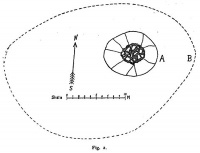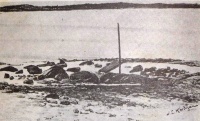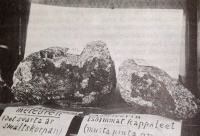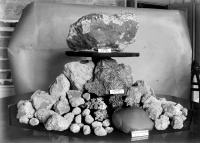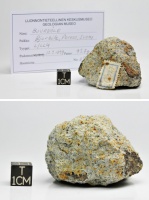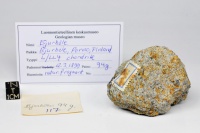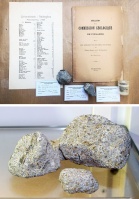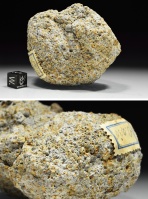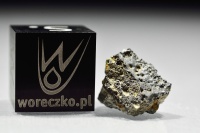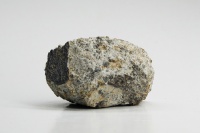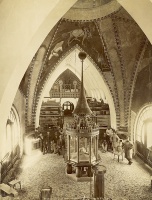(Unless otherwise stated, the copyright of the materials included belong to Jan Woreczko & Wadi.)
Bjurböle
Z Wiki.Meteoritica.pl
m (→Bibliography) |
m (→Bibliography) |
||
| (Nie pokazano 20 wersji pomiędzy niniejszymi.) | |||
| Linia 1: | Linia 1: | ||
__NOTOC__ | __NOTOC__ | ||
{{VerifyLevel|level=0}} | {{VerifyLevel|level=0}} | ||
| - | |||
| - | |||
| - | |||
'''{{Sparse-b}}This page was edited by Jarkko Kettunen.{{Sparse-e}}''' | '''{{Sparse-b}}This page was edited by Jarkko Kettunen.{{Sparse-e}}''' | ||
== The biggest fall in Scandinavia == | == The biggest fall in Scandinavia == | ||
| Linia 16: | Linia 13: | ||
| położenie = 60°24'N, 25°48'E | | położenie = 60°24'N, 25°48'E | ||
| uwagi = it is one of the few meteorites found underwater | | uwagi = it is one of the few meteorites found underwater | ||
| - | | data = Mar 12, 1899, 22:30 | + | | data = Mar. 12, 1899, 22:30 |
| typ = ordinary chondrite, L/LL4 | | typ = ordinary chondrite, L/LL4 | ||
| masa = 328 kg | | masa = 328 kg | ||
| liczba = one piece broke into many pieces | | liczba = one piece broke into many pieces | ||
| - | | synonimy = in NHM Cat: '''Bierbele''', '''Bjorböle''', '''Bjurboele''' | + | | synonimy = in NHM Cat: '''Bierbele''', '''Bjorböle''', '''Bjurboele'''; fin. ''Bjurbölen meteoriitti'' |
}} | }} | ||
| Linia 36: | Linia 33: | ||
Bjurböle is the biggest fall in Scandinavia with an extraordinary history. It is one of the few meteorites found underwater. | Bjurböle is the biggest fall in Scandinavia with an extraordinary history. It is one of the few meteorites found underwater. | ||
| + | |||
| + | == Collections == | ||
| + | |||
| + | Fragments of the Bjurböle meteorite in the largest collections: | ||
| + | :{| {{Koblitz Repository}} | ||
| + | ! Collection !! weight of fragments<br />(Koblitz MetBase) !! remarks | ||
| + | |- | ||
| + | | [[Helsinki, Geol. Mus. Univ.]] || 210 kg || [approx. weight] | ||
| + | |- | ||
| + | | Stockholm, Naturhist. Riksmus. || 21.2 kg || | ||
| + | |- | ||
| + | | [[Chicago, Field Mus. Nat. Hist.]] || 5641 g || | ||
| + | |- | ||
| + | | [[Washington, Natl. Mus. Nat. Hist.]] || 4 kg || | ||
| + | |- | ||
| + | | {{Wielokropek}} || || | ||
| + | |- | ||
| + | | [[Warsaw, Geol. Inst., Polish Acad. Sci.]] || 262 g || by Pilski (2001) [g]: 111.26 (fc), 44.51 (f), 13.34 (fc) | ||
| + | |} | ||
| + | |||
| + | == Location == | ||
| + | |||
| + | {{GEFrame-begin}} | ||
| + | {{GEMap | ||
| + | | htmlFileMap = wiki-Bjurbole.htm | ||
| + | | kml1 = http://wiki.meteoritica.pl/meteoritica/GoogleMaps/wiki-Finland-MM.kml | ||
| + | | kmlfit = http://wiki.meteoritica.pl/meteoritica/GoogleMaps/wiki-Bjurbole-fit.kml | ||
| + | | lat = 60.38 | ||
| + | | lon = 25.7 | ||
| + | | zoom = 9 | ||
| + | | type = terrain | ||
| + | }} | ||
| + | {{GEIcon-PointRed}} | ||
| + | (B) Bjurböle, (P) Porvoo | ||
| + | |||
| + | {{GEFrame-end}} | ||
| + | |||
| + | <br clear="all"/> | ||
| + | |||
| + | == Galleries == | ||
| + | |||
| + | Ramsay et al. (1902) | ||
| + | <gallery caption="" widths="200px" heights="160px" perrow="3"> | ||
| + | File:Bjurböle_(Ramsay_1902)-f2.jpg|A. Broken ice and the hole in B. the ice C. B. Area where mud and wather D. was spread | ||
| + | File:Bjurböle_(Ramsay_1902)-f3.jpg|Meteorite penetrated the 40 cm think ice and the 8 m deep layer of mud and clay | ||
| + | File:Bjurböle_(Ramsay_1902)-f4.jpg|Hole in the ice | ||
| + | File:Bjurböle_(Ramsay_1902)-f5.jpg|The biggest pieces of Bjurböle meteorite 80 and 21 kg. The main mass is in the collection of the University of Helsinki. The 21 kg piece is in the Stockholm Staatsmuseum | ||
| + | File:Bjurböle_(Finnish_Museum_of_Natural_History).jpg|A historic photo of Bjurböle and Marjalahti{{MBD-record |name=Marjalahti}} meteorites, the two biggest meteorite falls in [[Finlandia|Finland]]. Here is presented the main masses with some additional pieces, including the main mass of Hvittis.{{MBD-record|name=Hvittis}} Now in the collection of [[Szablon:HelsinkiGMU|Luonnontieteellinen keskusmuseo, Geologinen museo in Helsinki]] | ||
| + | </gallery> | ||
| + | |||
| + | |||
| + | <gallery caption="" widths="200px" heights="200px" perrow="3"> | ||
| + | File:Bjurböle_(Tomasz_Jakubowski).jpg|Fragment 93.7 g; collection Tomasz Jakubowski | ||
| + | File:Bjurböle_(Tomasz_Jakubowski)-1.jpg|Fragment 94 g; collection Tomasz Jakubowski | ||
| + | File:Bjurböle_(Toamsz_Jakubowski)-for_sale.jpg|Three Bjurböle specimens (93.7 g, 80.7 g, 15.3 g) (photo: Tomasz Jakubowski) | ||
| + | File:Bjurböle_(Jan_Woreczko).jpg|Fragment 226.4 g; collection [[Jan Woreczko]] | ||
| + | File:Bjurböle_(Jan_Woreczko)-crust.jpg|Fragment with fusion crust (0.55 g); collection Jan Woreczko | ||
| + | File:Bjurböle_(Jarkko_Kettunen)-crust.jpg|Fragment with fusion crust (21.7 g); collection Jarkko Kettunen | ||
| + | File:Magazyn_(ING_PAN_Kraków)-2.jpg|Fragments 111.26 (fc), 44.51 (f), 13.34 (fc) in the collection [[Muzeum Geologiczne PAN w Krakowie|Muzeum Geologicznego PAN w Krakowie]] | ||
| + | </gallery> | ||
| + | |||
| + | |||
| + | <gallery caption="" widths="200px" heights="200px" perrow="3"> | ||
| + | File:Bjurböle_(cast).jpg|A [[Meteoryty (kopie)|cast]] of the fragment exhibited at the World's fair, Paris 1900; now a museum in Helsinki | ||
| + | File:Bjurböle_(Paris_1900).jpg|'''World's fair, Paris 1900'''; Finland’s pavilion under construction. In the middle there is the showcase for Bjurböle meteorite | ||
| + | </gallery> | ||
== [[Bibliografia|Bibliography]] == | == [[Bibliografia|Bibliography]] == | ||
| - | * | + | * {{Koblitz MetBase}} |
| - | * | + | * {{Łaptaś (1998)}} |
| + | * Moilanen Jarmo, Kettunen Jarkko, (2016), '''Takaisin [[Bjurböle]]en!''', ''Tähdet ja avaruus'', 3, 2016, p. 42-45. | ||
| + | |||
| + | * {{Oja (1978)}} | ||
| + | |||
| + | * Ramsay Wilhelm, Borgström Leonhard Henrik, (1902), '''Die Meteorit von [[Bjurböle]] bei Borgå (''Mit 20 Figuren im Text'')''', ''Bulletin de la Commission Géologique de Finlande'', nr 12, Helsingfors 1902, pp. 28.<ref name="Borgström">[[Borgström_(ilustracje)|ilustracje z publikacji Borgströma]] z fińskim meteorytami</ref> Plik [https://paleoarchive.com/literature/Ramsay&Borgstrom1902-MeteoritBjurbole.pdf PDF]. | ||
| + | |||
| + | {{Koblitz References |1=One stone fell through the sea-ice and broke into fragments, the largest of which weighed 80kg, the total weight being about 330kg, M.H.Hey, Cat. Met., 1966, p.57. Described and analyzed, W.Ramsay and L.H.Borgström, Bull. Comm. Geol. Finlande, 1902, (12), p.1. Olivine Fa26, B.Mason, GCA, 1963, 27, p.1011. Further analysis, 20.71% total Fe, H.von Michaelis et al., Earth Planet. Sci. Lett., 1969, 5, p.387. Mjor element composition of chondrules, L.S.Walter, Meteorite Research, ed. P.M.Millman, D.Reidel, Dordrecht-Holland, 1969, p.191. Ar-Ar dating, G.Turner, Meteorite Research (ed. P.M.Millman), 1969, p.405. Modal analysis, G.Dörfler and H.G.Hiesböck, Meteorite Research, ed. P.M.Millman, D.Reidel, Dordrecht-Holland, 1969, p.669. Xe isotope data, E.C.Alexander,Jr. and O.K.Manuel, GCA, 1969, 33, p.298. Ni and Ir contents, O.Müller et al., GCA, 1971, 35, p.1121. Uranium content, D.E.Fisher, GCA, 1972, 36, p.15. Oxygen isotopic composition, N.Onuna et al., GCA, 1972, 36, p.157. Partial INAA, R.A.Schmitt et al., Meteoritics, 1972, 7, p.131. Ga and Ge contents of metal phase, C.-L.Chou and A.J.Cohen, GCA, 1973, 37, p.315. Hg abundance, N.A.Ozerova et al., GCA, 1973, 37, p.569. Magnetic properties, P.J.Wasilewski, Meteoritics, 1973, 8, p.451 (abs.). Chondrule size distribution, Y.I.Stakheev et al., Meteoritika, 1973, 32, p.103. Al-26 data, I.R.Cameron and Z.Top, GCA, 1974, 38, p.899, GCA, 1975, 39, p.1705. Nitrogen content, B.K.Kothari and P.S.Goel, GCA, 1974, 38, p.1493. Oxygen isotopic composition of matrix, R.N.Clayton et al., Earth Planet. Sci. Lett., 1976, 30, p.10. Further analysis, 18.95% total Fe, A.J.Easton and C.J.Elliott, Meteoritics, 1977, 12, p.409. Exposure age based on spallogenic Mn-53 content, P.Englert and W.Herr, GCA, 1978, 42, p.1635. Chondrule microstructure, K.Fredriksson et al., Meteoritics, 1978, 13, p.462 (abs.). Magnetic properties, T.Nagata, Mem. Nat. Inst. Polar Res., Tokyo, 1979, (12), p.223. U-Pb chronology, D.M.Unruh and M.Tatsumoto, LPSC, 1980, 11, p.1184 (abs.). Particle track data of chondrules, J.S.Allen et al., GCA, 1980, 44, p.1161. Calculation of atmospheric ablation based on cosmic ray tracks and Ne isotopes, N.Bhandari et al., Nucl. Tracks, 1980, 4, p.213. Xe isotopic composition of neutron irradiated samples, C.M.Hohenberg and B.M.Kennedy, GCA, 1981, 45, p.251. Lu/Hf isotope data, P.J.Patchett and M.Tatsumoto, LPSC, 1981, 12, p.822 (abs.). Fission track densities in whitlockite and orthopyroxene, P.Pellas, LPSC, 1981, 12, p.825 (abs.). Magnetic properties, N.Sugiura and D.W.Strangway, Mem. Nat. Inst. Polar Res., Tokyo, 1982, (25), p.260; of chondrules, P.J.Wasilewski et al., LPSC, 1995, 26, p.1467 (abs.). I-Xe ages of individual chondrules, M.W.Caffee et al., J. Geophys. Res., 1982, 87 (suppl.), p.A303. Study of shock-induced trace element mobilization, T.M.Walsh and M.E.Lipschutz, GCA, 1982, 46, p.2491. Al-26 and Mn-53 data, Ne-21 exposure ages, U.Herpers and P.Englert, J. Geophys. Res., 1983, 88 (suppl.), p.B312. Study of fusion crust, F.J.M.Rietmeijer and I.D.R.MacKinnon, J. Geophys. Res., 1984, 89 (suppl.), p.B597; see also, LPSC, 1983, 14, p.644 (abs.). Study of fluid inclusions, R.L.Rudnick et al., J. Geophys. Res., 1985, 90 (suppl.), p.C669. Mineral analysis data, olivine Fa25.8, orthopyroxene Fs21.0, E.R.D.Scott et al., J. Geophys. Res., 1985, 90 (suppl.), p.D137. Br and Se contents, D.Wang et al., Papers 10th Symp. Ant. Met., NIPR Tokyo, 1985, p.15. Si isotopic composition of chondrules, C.Molini-Velsko et al., GCA, 1986, 50, p.2719. REE fractionation among chondrules, T.Nakayama and N.Nakamura, Papers 11th Symp. Ant. Met., NIPR Tokyo, 1986, p.116. Rb-Sr and Sm-Nd isotopic composition of phospates, J.C.Brannon et al., LPSC, 1987, 18, p.121 (abs.). Mg isotopic composition of chondrules, A.E.Kinsey et al., LPSC, 1988, 19, p.603 (abs.). Study of tracks in olivine, N.N.Korotkova et al., LPSC, 1988, 19, p.639, 641 (abs.). Chondrule size distribution, B.Lang and K.Franaszczuk, LPSC, 1988, 19, p.659 (abs.). Sulfur isotopic composition of chondrules and matrix, X.Gao and M.H.Thiemens, LPSC, 1989, 20, p.1221 (abs.). Pu, U, and Nd abundances in merrillite and apatite, G.Crozaz et al., Earth Planet. Sci. Lett., 1989, 93, p.157. Major and trace element data, shock facies, weathering state, intermediate in composition between L and LL group chondrites, G.W.Kallemeyn et al., GCA, 1989, 53, p.2747. Analysis of olivine and kamacite, 1.26% Co, A.E.Rubin, GCA, 1990, 54, p.1219. Composition of olivine and chromite in type II chondrules, C.A.Johnson and M.Prinz, GCA, 1991, 55, p.893. Oxygen isotopic composition, R.N.Clayton et al., GCA, 1991, 55, p.2317. Petrographic shock classification, D.Stöffler et al., GCA, 1991, 55, p.3845. Study of the diffusion properties of the I-Xe system, M.K.Burkland and T.D.Swindle, LPSC, 1992, 23, p.185 (abs.). Study of radiogenic Xe-129 release, M.K.Burkland et al., LPSC, 1993, 24, p.167 (abs.). Bulk density and porosity, M.Terho et al., Studia Geophysica et Geodaedica, 1993, 37, p.65; see also, D.T.Britt and G.J.Consolmagno, MAPS, 2003, 38, p.1161; L.J.Personen et al., Proc. NIPR Symp. Ant. Met., 1993, (6), p.401; C.M.Corrigan et al., MAPS, 1997, 32, p.509. Cu content, A.E.Rubin, Meteoritics, 1994, 29, p.93. Boron data, M.Zhai and D.M.Shaw, Meteoritics, 1994, 29, p.607; and isotopic composition, M.Zhai et al., GCA, 1996, 60, p.4877. I-Xe dating of chondrules, J.D.Gilmour et al., Meteoritics, 1995, 30, p.405; see also, J.A.Whitby et al., Meteoritics, 1995, 30, p.599 (abs.). Isothermal heating experiments on I-Xe dating standard, M.K.Burkland et al., GCA, 1995, 59, p.2085. Study of shock features in metal and troilite, M.E.Bennett and H.Y.McSween,Jr., MAPS, 1996, 31, p.255. Chondrule size distribution, K.E.Kuebler and H.Y.McSween,Jr., LPSC, 1996, 27, p.715 (abs.); and mass equivalence, K.E.Kuebler et al., LPSC, 1997, 28, p.773 (abs.); see also, MAPS, 1997, 32, p.A75 (abs.). Sm-Nd isotopic composition of individual chondrules, N.Krestina et al., LPSC, 1997, 28, p.761 (abs.); see also, MAPS, 1997, 32, p.A73 (abs.). Oxygen isotopic compositions of chondrules, R.D.Ash et al., MAPS, 1997, 32, p.A8 (abs.). I-Xe data of bulk rock, J.D.Gilmour et al., MAPS, 1997, 32, p.A48 (abs.). Study of magnetic remanence in chondrules, P.Wasilewski and T.L.Dickinson, Papers 23rd Symp. Ant. Met., NIPR Tokyo, 1998, p.166 (abs.); see also, MAPS, 2000, 35, p.537. Effect of thermal heating on the I-Xe system, M.K.Burkland and T.D.Swindle, MAPS, 1998, 33, p.A27 (abs.). Cosmic-ray exposure ages of matrix and chondrules, E.Polnau et al., MAPS, 1998, 33, p.A124 (abs.). Absolute and relative I-Xe ages for phosphate separates, R.H.Brazzle et al., GCA, 1999, 63, p.739. EPMA analysis of fusion crust, M.J.Genge and M.M.Grady, MAPS, 1999, 34, p.341. Physical properties, G.J.Flynn et al., LPSC, 1999, 30, abs. #1073. Differences in Sm-Nd isotopic composition between chondrule rims and chondrule cores, N.Krestina et al., LPSC, 1999, 30, abs. #1918. Determination of porosity and grain and bulk density, L.B.Moore et al., LPSC, 1999, 30, abs. #1128. Chemical, petrological, hydrogen isotopic and textural study of bleached chondrules, J.N.Grossman et al., MAPS, 2000, 35, p.467. Boron abundances and isotopic composition of chondrules, P.Hoppe et al., MAPS, 2001, 36, p.1331. 53Mn-53Cr systematics, T.Tomiyama and K.Misawa, Evolution of Solar System Materials: A New Perspective from Antarctic Meteorites, NIPR Tokyo, 2003, p.140 (abs.). Magnetic susceptibility, P.Rochette et al., MAPS, 2003, 38, p.251. Density and porosity, S.L.Wilkinson et al., MAPS, 2003, 38, p.1533. Study of porosity and density heterogeneity, S.L.Andre et al., LPSC, 2003, 34, abs. #1608. Pb-Pb dating, E.Rotenberg and Y.Amelin, LPSC, 2003, 34, abs. #1902. Cu isotopic composition, J.M.Luck et al., GCA, 2003, 67, p.143. Minor and trace element abundances, J.M.Friedrich et al., GCA, 2003, 67, p.2467. Petrographic study of shock features, A.E.Rubin, GCA, 2004, 68, p.673. Zn abundance and isotopic composition, J.-M.Luck et al., GCA, 2005, 69, p.5351. Spectral parameters for VIS-NIR reflectance, R.Duffard et al., MAPS, 2005, 40, p.445. Cr-spinel and chromite thermometry, F.Wlotzka, MAPS, 2005, 40, p.1673. Paleomagnetic record in separated chondrules, G.Kletetschka et al., MAPS, 2005, 40, No. 9 (Suppl.), p.A83 (abs.).}} | ||
{{Przypisy|lang=en}} | {{Przypisy|lang=en}} | ||
| + | |||
| + | == See also == | ||
| + | |||
| + | * [[Szablon:HelsinkiGMU|Finnish Museum of Natural History]] | ||
| + | |||
| + | * [[Meteoryty (kopie)|Meteorites casts]] | ||
== External links == | == External links == | ||
| Linia 49: | Linia 125: | ||
* '''Meteoritical Bulletin Database ([http://www.lpi.usra.edu/meteor/metbull.php MBD])''' – meteorite [http://www.lpi.usra.edu/meteor/metbull.php?code=5064 Bjurböle] | * '''Meteoritical Bulletin Database ([http://www.lpi.usra.edu/meteor/metbull.php MBD])''' – meteorite [http://www.lpi.usra.edu/meteor/metbull.php?code=5064 Bjurböle] | ||
* '''Encyclopedia of Meteorites ([http://www.encyclopedia-of-meteorites.com/ EoM])''' – meteorite [http://www.encyclopedia-of-meteorites.com/meteorite.aspx?id=5064 Bjurböle] | * '''Encyclopedia of Meteorites ([http://www.encyclopedia-of-meteorites.com/ EoM])''' – meteorite [http://www.encyclopedia-of-meteorites.com/meteorite.aspx?id=5064 Bjurböle] | ||
| + | |||
| + | * {{HelsinkiGMU}} | ||
* '''LittlePlanets.fi''', Jarkko Kettunen – [http://www.littleplanets.fi/portfoliocpt/bjurbole/ Bjurböle] | * '''LittlePlanets.fi''', Jarkko Kettunen – [http://www.littleplanets.fi/portfoliocpt/bjurbole/ Bjurböle] | ||
| + | * woreczko.pl – [http://www.woreczko.pl/meteorites/news/Bjurbole.htm Bjurböle] | ||
| + | |||
| + | * Wikimedia – [https://commons.wikimedia.org/wiki/File:Finnish_meteorites_-_Meteorites_in_the_Arppeanum_-_DSC05473.JPG Finnish meteorites - Meteorites in the Arppeanum] | ||
[[Category:Poza granicami Polski]] | [[Category:Poza granicami Polski]] | ||
| + | [[Category:Finlandia]] | ||
Aktualna wersja na dzień 21:03, 27 lip 2023
This page was edited by Jarkko Kettunen.
| Bjurböle → | |
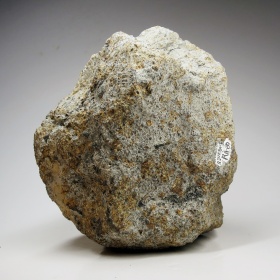
Fragment 3 kg; collection Jarkko Kettunen (size: 11.0×9.0×8.0 cm)
| |
| Fell | |
| Location | Porvoo, Uusimaa, Finland |
| Coordinates[1] | 60°24'N, 25°48'E |
| Date | Mar. 12, 1899, 22:30 |
| Remarks | it is one of the few meteorites found underwater |
| Characteristics | |
| Class | ordinary chondrite, L/LL4 |
| Mass | 328 kg |
| Pieces | one piece broke into many pieces |
| Meteoritical Bulletin Database | |
| Synonyms → | |
| in NHM Cat: Bierbele, Bjorböle, Bjurboele; fin. Bjurbölen meteoriitti | |
Bjurböle is the biggest meteorite ever found in Finland. The total weight of the founded pieces is 328 kg. Later it became clear that some of the men who lifted the meteorite pieces from the bottom of the sea, had took some pieces for them shelves. Those pieces were sold to different people in the area of town Porvoo. When this mass is added to the 328 kilos the total weight of the Bjurböle meteorite was around 400 kg.
On the 12th of March 1899 a bright fireball was seen over the Baltic sea. In the capital of Finland, in Helsinki, this event aroused great attention. The newspaper Päivälehti told the following:
“A big bright meteor with a long blasing tail whizzed over our city at 9:30 pm from northwest to southeast. The meteor lightened it's surroundings like a gigantic electric bulp. The clouds seemed to be golden-haired and spreaded hither and thither. After about one minute meteor broke into small pieces with a terrible thunder. This sound lasted many minutes. The bang made the houses shook up to their foundations. People hastened out of their apartments and houses to streets and yards. Some thought it was big cannons firered in the Fortress Viaborg and some thought it is the end of the world. If we have it correct, the same phenomenon was seen in the western and eastern side of the city. To get a better knowledge about this phenomenon we urge citizens to send their observations to the weather observatory. It is important to know when and how long the phenomenon was seen, how much time was between the appearance of the meteor and the thunder, how long thunder lasted and what direction the phenomenon went. It would be good if the viewer would have drawing showing the direction of the meteor compared to the location of the viewer.”
These witness reports were important to get a good information of the meteors trajectory. The fireball was seen all around Baltic sea and Southern Finland. The fireball passed Helsinki from the south side, over the Baltic sea. The altitude was around 20 kilometer. The fireball hit an ice covered sea bay on the southern side of the town Porvoo, 50 km east of Helsinki. Next day a 3-4 meters wide hole in the ice was found close to the shore. A big amount of mud was spread all around the hole in the ice. Meteorite had went through the 40 cm thick ice. The water was only 50 cm deep under the ice, but after that there was a 8 meters deep layer of mud and clay before the bedrock. With long sticks people tried to find the meteorite itself, but that did not succeed in the beginning. Because it was sure that this was exact the point were the meteorite had hit it was build a waterproof wooden well out of wooden beams. This wooden well was shunken through the hole in the ice to the bottom of the mud layer. Then well was emptied out of water and mud. This did not succeed completely, but in the end a diver was able to find the meteorite and pulled the pieces up to the ice.
The biggest pieces weight 80, 21, 18 and 17 kg. The biggest piece is 30-40 cm thick. The whole meteorite has been 1 m wide before break down to pieces. After the meteorite was recovered it needed to dry before it was able to be researched. Bjurböle meteorite is very soft and fragile material and breaks very easy. Bjurböle is a ordinary chondrite with great chondrules that size from very small to the size of fingertip. Two owner of the property where the meteorite had fallen received a 500 Finnish marks compensation for the damages that has happened to the fish spawning place. This money was given forward to the benefit of the local school.
Bjurböle is the biggest fall in Scandinavia with an extraordinary history. It is one of the few meteorites found underwater.
Collections
Fragments of the Bjurböle meteorite in the largest collections:
Collection weight of fragments
(Koblitz MetBase)remarks Helsinki, Geol. Mus. Univ. 210 kg [approx. weight] Stockholm, Naturhist. Riksmus. 21.2 kg Chicago, Field Mus. Nat. Hist. 5641 g Washington, Natl. Mus. Nat. Hist. 4 kg (…) Warsaw, Geol. Inst., Polish Acad. Sci. 262 g by Pilski (2001) [g]: 111.26 (fc), 44.51 (f), 13.34 (fc)
Location
(B) Bjurböle, (P) Porvoo
* W 2018 roku Google zmieniło zasady działania apletu, mapa może wyświetlać się niepoprawnie (pomaga Ctrl+F5); więcej → Szablon:GEMap-MyWiki
Galleries
Ramsay et al. (1902)
A historic photo of Bjurböle and Marjalahti[2] meteorites, the two biggest meteorite falls in Finland. Here is presented the main masses with some additional pieces, including the main mass of Hvittis.[3] Now in the collection of Luonnontieteellinen keskusmuseo, Geologinen museo in Helsinki |
Fragment 226.4 g; collection Jan Woreczko |
||
Fragments 111.26 (fc), 44.51 (f), 13.34 (fc) in the collection Muzeum Geologicznego PAN w Krakowie |
A cast of the fragment exhibited at the World's fair, Paris 1900; now a museum in Helsinki |
Bibliography
- Koblitz Jörn, MetBase. Meteorite Data Retrieval Software, Version 7.3 (CD-ROM), Ritterhude, Germany 1994-2012. MetBase.
- Łaptaś Andrzej, Ćwiżewicz Małgorzata, (1998), Meteoryty w zbiorach Muzeum Geologicznego w Krakowie, Muzeum Geologiczne ING PAN, Kraków 1998, ss. 34. ISBN 83-909970-1-0.
- Moilanen Jarmo, Kettunen Jarkko, (2016), Takaisin Bjurböleen!, Tähdet ja avaruus, 3, 2016, p. 42-45.
- Oja Heikki, (1978), Tulipalloja taivaalla, Tähtitieteellinen yhdistys Ursa, Helsinki 1978, pp. 208.[4] File doi.
- Ramsay Wilhelm, Borgström Leonhard Henrik, (1902), Die Meteorit von Bjurböle bei Borgå (Mit 20 Figuren im Text), Bulletin de la Commission Géologique de Finlande, nr 12, Helsingfors 1902, pp. 28.[5] Plik PDF.
Footnotes
See also
External links
- Meteoritical Bulletin Database (MBD) – meteorite Bjurböle
- Encyclopedia of Meteorites (EoM) – meteorite Bjurböle
- Fińskie Muzeum Historii Naturalnej w Helsinkach (Finnish Museum of Natural History, University of Helsinki; Helsinki, Geol. Mus. Univ.) – Luonnontieteellinen keskusmuseo, Helsingin yliopisto ● Exhibitions in the Mineral Cabinet
- Wikimedia – Finnish meteorites - Meteorites in the Arppeanum
